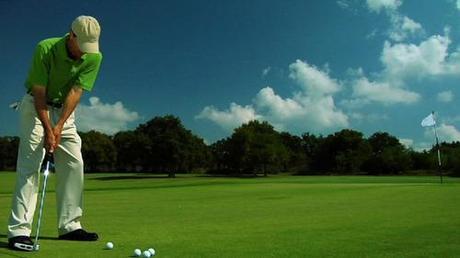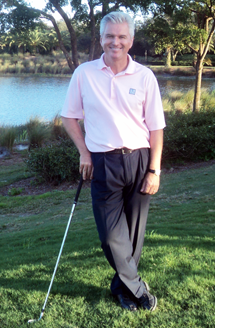
***************
Long putting, or lag putting as it is often called, is a key to good scoring in golf.
On the PGA Tour, the players make an average of just fifty percent of their putts from eight feet, which means that the everyday golfer will do well to make fifty percent of their six-foot putts! The current strokes-gained putting leader? Bryce Molder! These may seem like low averages, but there is a lot that can go wrong on a short putt; spike marks and other imperfections on the green, a slight misread, a lip out, etc.
When putting from, say, more than twenty-five feet, you will find it is very easy to misjudge the distance by six feet or more, whereas it is unlikely that you will miss left or right by more than a couple of feet. This is why distance control is so important.
The two biggest components in good distance control are good visualization, or green reading, and proper rhythm in the stroke. Both require practice to become reliable.
Simply watching a lot of putts roll (practice) will help you read greens and become a good visualizer of putts. A test of your visualization skills is that once a long putt is a third of the way to the hole you should be able to estimate pretty accurately whether it is going long, short, or about the right distance.
Only when a golfer can fairly accurately see the ball rolling in their mind at the correct speed across the green BEFORE they step over the putt can they expect to be able to feel the desired stroke.

Regarding rhythm, there are a few objectives to understand:
- In a pendulum, the length of the backstroke and through stroke are the same; this is due to gravity.
- It is also true that in a pendulum maximum speed is reached at the very bottom of the arc. However, most people don't realize that at the bottom of the arc there is NO acceleration, it has reached maximum speed.
The middle of the arc is, therefore, right where we want to make contact with the golf ball in our stroke, the point with the most speed and the least "Hit" or acceleration. I strongly recommend that you practice this at times without aiming at a hole, just focusing on your motion.
A great drill is to place two tees in the green, say three feet apart (vary this drill), and hit some putts placing the ball right in between the tees, and slightly to the side of them in order to allow you to hit a putt. Don't over-control the putter with your hands, but feel the pendulum rhythm of your stroke until the putter head goes evenly from tee to tee and you can roll several balls the same distance. Once this becomes natural you are on your way to better putting!
One final point, the time each stroke takes (think of a metronome) should always be the same. This means that the putter will have to be swung faster throughout the motion (not just in the forward swing) on longer putts than shorter putts. The rhythm, such as tick-tock, will then always be a constant.
Best of luck with this...now go practice!
About the Author:
 Adam Bazalgette grew up in London, England, where he took up golf. He has been teaching golf full-time since 1992.
Adam Bazalgette grew up in London, England, where he took up golf. He has been teaching golf full-time since 1992. Adam worked for David Leadbetter in Orlando and in 1994 was promoted to the Academy Director at the Leadbetter’s Naples facility.
Adam currently is the director of golf instruction at The Club at Mediterra in Naples Florida and has held this position for the last six years. Make sure to visit his site at http://adambgolf.com for private lessons if your going to be in the Naples Florida area!
Say hi to Adam Bazalgette on Twitter and like on Facebook!
AND...Voice your opinion on Twitter @Golf4Beginners and friend on Facebook!
photo credit: activerain.com, Adam Bazalgette Posted via email from stacysolomon's posterous

